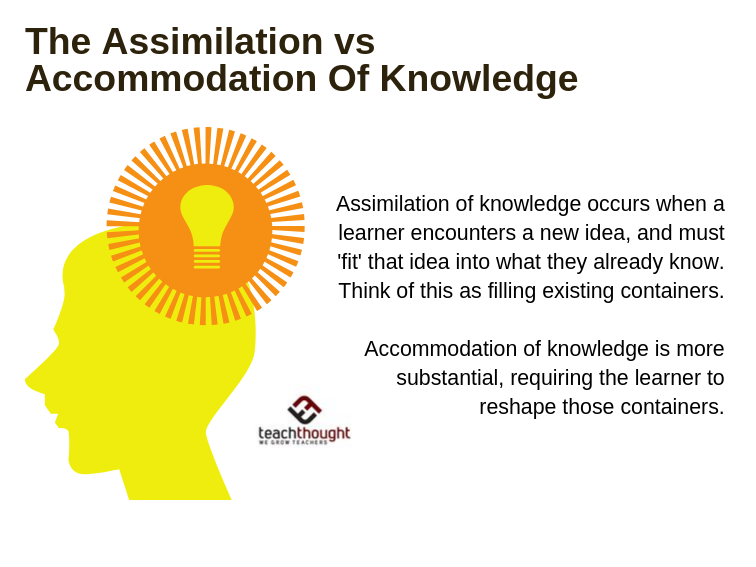The Difference Between The Assimilation And The Accommodation Of Knowledge
by Terry Heick
Learning is a natural response to encountering something new.
Within Jean Piaget’s theories on cognitive development are related ideas on how children process knowledge. Piaget was interested in how children organize ‘data’ and settled on two fundamental responses stimuli: assimilation of knowledge, and accommodation of knowledge.
Assimilation of knowledge occurs when a learner encounters a new idea, and must ‘fit’ that idea into what they already know. Think of this as filling existing containers.
Accommodation of knowledge is more substantial, requiring the learner to reshape those containers.
See also 20 Of The Best Quotes About Knowledge
You can think of these containers as ‘schema.’ Schema are fluid and constantly evolving vessels students use to process what they see, read, and feel. The following from the University of Puget Sound is a simple example clarifying the difference between assimilation and accommodation of knowledge.
“When a child learns the word for dog, they start to call all four-legged animals dogs. This is assimilation. People around them will say, no, that’s not a dog, it’s a cat. The schema for dog then gets modified to restrict it to only certain four-legged animals. That is accommodation.
“Assimilation is like adding air into a balloon. You just keep blowing it up. It gets bigger and bigger. For example, a two year old’s schema of a tree is “green and big with bark” — over time the child adds information (some trees lose their leaves, some trees have names, we use a tree at Christmas, etc.) – Your balloon just gets full of more information that fits neatly with what you know and adds onto it.
Accommodation is when you have to turn your round balloon into the shape of a poodle. This new balloon ‘animal’ is a radical shift in your schema (or balloon shape)….Now that they are in college in the redwood forest, we have conceptualization (schema) of trees as a source of political warfare, a commodity, a source of income for some people, we know that people sit and live in trees to save them; in other words, trees are economic, political, and social vehicles. This complete change in the schema involves a lot of cognitive energy, or accommodation, a shift in our schema.”
Background Knowledge
Students come to the classroom with an incredibly diverse set of experiences. This isn’t just a matter of content knowledge or reading levels either. Students adapt their own thinking—both in process and in form—in response to the kinds of input they’ve been exposed to.
A childhood of ranging, divergent thinking that varies in depth, form, and tone can provide a ‘schema’ that more readily accepts new ideas, or has provided the student with an increased sense of self-efficacy in making the effort to do so. This sort of divergence doesn’t have to be academic, either. Experience is experience.
Piaget thought of these as processes–assimilating and accommodating knowledge–as both interactive (one affecting the other) and capable of overlapping. When a child encounters stimuli without assimilating or accommodating it–or without being capable of assimilation or accommodation –they will fail to “understand.” Whatever new idea they encountered will either have to be further parsed and analyzed, or discarded.
So for you as a teacher, what does this imply?
6 Tips For Schema-Friendly Teaching
1. Know the basics
Know that schema can be thought of as templates or vessels students use to organize knowledge.
Know the difference between assimilating knowledge and accommodating knowledge.
Know that the latter is more difficult than the former.
And know that what’s happening at the cognitive level will be different for every student because their schema is nuanced and unique.
2. It’s cultural
It’s also a matter of culture. Students with access to WiFi at home will have a much greater opportunity for ‘broadband schema’–that is, the kind of schema that is diverse, digital, and at times random and nonsensical. The same with students raised on farms, in the city, in single-parent homes, and so on.
Schema is cultural because we’re human.
3. Diversify your teaching strategies
This all suggests diversity. One size fits all doesn’t fit anyone even at the brain level.
4. Encourage self-direction
Students will naturally seek out ideas that either align with their own (which isn’t necessarily good), or may be less alarmed to encounter competing thoughts on their own terms when learning on their own.
5. Don’t project what–and how–you understand on students
It’s tempting to project your own understanding and preferences onto students as well. What ‘makes sense’ to you is powerful, and it can be hard to get around that no matter how much you recognize it intellectually. But it’s based on your own schema, scale, and timeline.
Learning is different for everyone.
6. Practice, practice, practice
Allow students to encounter ideas over and over again from a variety of perspectives, using different ‘vessels.’ This also suggests spiraling big ideas in your curriculum. Being exposed to academic standards only a few times in limited number or forms limits a student’s ability to effectively reform said data into useful schema.

